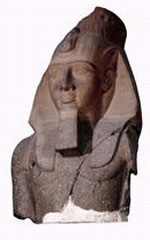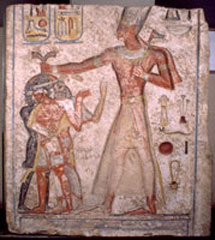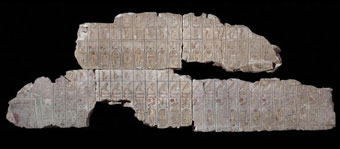Pre-nomen is usermaatre setepenre, translation: The Justice of Re is Powerful, Chosen of
Re, transliteration: wsr-mAat-ra stp.n-ra After its arrival in The British Museum the 'Younger
Memnon' was perhaps the first piece of Egyptian sculpture to be recognized as a work of art by connoisseurs, who traditionally
judged things by the standards of ancient Greek art.
The Trustees of the British Museum purchased the sculpture from Henry Salt in 1822. For several years it was displayed in
the old Townley Galleries (now demolished). By 1834 the present Egyptian Sculpture Gallery had been built. Because of the
enormous weight of some of these sculptures, the Museum had to call on the help of the Army to move them into the new gallery. Related articles  Ramesses II, "the
Great", ruled 1279-1213 BC
Ramesses II, "the
Great", ruled 1279-1213 BC
Ramesses II became the third
king of the 19th Dynasty at the age of twenty-five. In his sixty-seven year reign he probably built more temples and sired
more children than any other Egyptian king. Today, he is often called Ramesses 'the great'.
 He founded a new capital, Pi-Ramesse in the eastern Delta, which remained the royal residence throughout the Ramesside period.
He also built a vast number of temples throughout Egypt and Nubia. The most famous of these are the rock cut temple at Abu
Simbel, and his mortuary temple at Thebes, the Ramesseum. The tomb of his principal wife, Nefertari, at Thebes is one of
the best-preserved royal tombs. The tomb of many of his sons has also recently been found in the Valley of the Kings (KV5).
Ramesses II was buried in the Valley of the Kings and his body was found in the Deir el-Bahari cache.
He founded a new capital, Pi-Ramesse in the eastern Delta, which remained the royal residence throughout the Ramesside period.
He also built a vast number of temples throughout Egypt and Nubia. The most famous of these are the rock cut temple at Abu
Simbel, and his mortuary temple at Thebes, the Ramesseum. The tomb of his principal wife, Nefertari, at Thebes is one of
the best-preserved royal tombs. The tomb of many of his sons has also recently been found in the Valley of the Kings (KV5).
Ramesses II was buried in the Valley of the Kings and his body was found in the Deir el-Bahari cache.
For Ramesses II, the most momentous event in his reign was the battle of Kadesh, fought against the Hittites. On his monuments,
the battle was commemorated as a great victory. However, the Hittite account, found at their capital, Hattusas, suggests
that the battle was closer fought.
Nomen is ramesisu meriamon, translation: Born of Re, beloved of Re, transliteration: ra-msi-sw mri-imn

Bust of a granite statue of
Ramesses II
From Aswan, Elephantine Island, 19th Dynasty, around 1250 BC
From the Temple of Khnum
Many of the main attributes of Egyptian royalty are visible on this statue of King
Ramesses II (1279-1213 BC). He is shown
wearing the two crowns of Upper and Lower Egypt, symbolizing the king's control over the country; in his hands are the crook
and the flail, which represent his power over his subject; and on his brow is the Uraeus, the cobra snake ready to attack
any who dare to oppose him.
The beard he wears would have been false (though perhaps made of real hair) and is shown attached to his crown using straps
which probably fastened round the ear. The beard is of a type only worn by the king; the beards of gods tend to curl at
the ends, while those of ordinary people are shown as much shorter. The king's names are cut on his shoulders, he wears
a collar, and there is an elaborate bracelet on his right wrist.

Colossal bust of Ramesses II, the 'Younger Memnon'
From the Ramesseum, Thebes, 19th Dynasty, about 1250 BC
One of the largest pieces of Egyptian sculpture in the British Museum
Ramesses II succeeded his father Sety I in around 1279 BC and ruled for 67 years.
Weighing 7.25 tons, this fragment of his statue was cut from a single block of two-coloured granite. He is shown wearing
the Nemes head-dress surmounted by a cobra diadem. The sculptor has used a slight variation of normal conventions to relate
his work to the viewer, angling the eyes down slightly, so that the statue relates more to those looking at it. It was retrieved
from the mortuary temple of Ramesses at Thebes (the 'Ramesseum') by Giovanni Belzoni in 1816. Belzoni wrote a fascinating
account of his struggle to remove it, both literally, given its colossal size, and politically. The hole on the right of
the torso is said to have been made by members of Napoleon's expedition to Egypt at the end of the eighteenth century, in
an unsuccessful attempt to remove the statue. The imminent arrival of the head in England in 1818 inspired the poet Percy
Bysshe Shelley to write Ozymandias.

William Alexander, Installing the Bust of
Ramesses II in the
Egyptian Sculpture Gallery
The British Museum, London, England, May 1834
The colossal stone bust of the Egyptian king Ramesses II weighs 16 tons and dates from about 1270 BC. It was sent to England
in 1816 by Henry Salt, the British Consul-General in Egypt. At the start of its journey it was tied to wooden rollers, on
which it was pulled by ropes to the banks of the River Nile by hundreds of workmen. It was then floated down the river and
taken to England by ship.
Alexander made this sketch while he was watching the head being lifted into place. It shows soldiers of the Royal Engineers
using heavy ropes and lifting equipment under the command of Major Charles Cornwallis Dansey (the figure sitting towards
the front of the scene). Dansey had fought at the Battle of Waterloo nearly twenty years earlier, and had received a wound
which had left him lame. For this reason he was allowed to sit while directing his men.

Ozymandias,
Percy Bysshe Shelly (1792 - 1822)
I met a traveller from an antique land,
Who said: Two vast and trunkless legs of stone
Stand in the desert… Near them, on the sand,
Half sunk, a shattered visage lies, whose frown,
And wrinkled lip, and sneer of cold command,
Tell that its sculptor well those passions read
Which yet survive, stamped on these lifeless things,
The hand that mocked them, and the heart that fed;
And on the pedestal, these words appear:
"My name is Ozymandias, King of Kings,
Look on my Works, ye Mighty, and despair!"
Nothing beside remains. Round the decay
Of that colossal Wreck, boundless and bare
The lone and level sands stretch far away."
Shelly's couplet is similar to Diodorus's writing (the only classical author to mention Ozymandias) - Shelly, Banks etc
were classical student. Diodorus wrote "I am Ozymandias, king of Kings. If anyone would know how great I am
and where I lie let him surpass any of my works". He also wrote that the statue of Ozymandias was "... the biggest
of all those amongst the Egyptians". It is accepted that the name Ozymandias is derived from Usermare (Ramesses II
pre-nomen meaning Justice of Re is Powerful, Chosen of Re).
Fragment of the Kings List of Ramesses
and Sety I's temples at Abydos - British Museum
Glazed stealite plaque, Ashmolean Museum
Fragment of panel commemorating the Coronation - Bristol Museum
Figure of a falcon inscribed , 19th Dynasty from Tell el-Maskhuta
- British Museum
Wooden coffin lid - Cairo Museum
One
of a pair of armlets in gold with inlays - Cairo Museum
Dark granite statue of a 12th
or 13th Dynasty king, usurped by Ramesses II - Cairo Museum
Relief showing
Ramesses about to
smite prisoners - Cairo Museum
Head of Ramesses carved from Red Granite, reused in the Temple
of Bast, Bubastis - Liverpool Museum
Base for a Statue, traditional enemies of Egypt and vassals
carved on the block - Liverpool Museum
Statue of Mut, carved in Calcite - Luxor Museum
Alabaster 'Pilgrim bottle' with Gold mountings
and blue cartouches of Ramesses and Queen Nefertari - Petrie Museum
Prince Khaemwaset offering
to the god Ptah in the form of the Apis Bull, son of Ramesses - Rosicrucian Museum
Statue of Ramesses
II (the Great) - Museo Egizio di Turino
Stela of Ramose and Mutemula
- Museo Egizio di Turino
Turin Royal Canon - Museo Egizio di Turinoa
Relief showing Setau, a viceroy of Ramesses
II making an offering to Renenutet - British Museum
Sandstone relief showing Setau, a viceroy of Ramesses II making an offering to Renenutet - British Museum
Black granite statue from Nebesheh (in the Nile
Delta) - Boston Museum Limestone statue - Fitzwilliam
Museum
Earthenware Funerary Cone - Fitzwilliam Museum
Quartzite statue of Nefer-Tari, wife of
Ramesses
II - Fitzwilliam Museum
Clay plaque mould for a Cartouche - Fitzwilliam
Museum